Page, K., Ammonites, anoxia and time. Geoscientist
30 (4), 10-15, 2020
https://doi.org/doi: 10.1144/geosci2019-080,
Download the pdf here
Kevin Page on how ammonites are helping geologists pinpoint a crucial moment in Earth’s history
The early part of the Toarcian Stage of the Lower Jurassic is famous for one of the most extreme phases of oceanic anoxia in the geological record, often referred to as the TOAE (Toarcian Oceanic Anoxic Event). It also featured one of the largest carbon isotope excursions (CIE) of the last 250 Ma, and is claimed to coincide with a mass extinction event.
Various causes for the TOAE have been proposed. One of the most popular is the release of isotopically light carbon from methane hydrates in marine sediments, linked to a phase of global warming as a result of the greenhouse climate effects of large scale volcanism – hence very much an Earth system crisis. The ‘event’ is also widely interpreted to have led to a single phase of oceanic anoxia globally and hence the deposition of organic-rich mudrocks, some with a total organic carbon content (TOC) approaching 20% –indeed, some models actually require it to be a single event.
Nevertheless, this synchronicity has been questioned by some authors who have presented evidence that it is either diachronous across Europe, between the southern Tethyan and northern Boreal areas, or even that there may be several events. Beyond Europe, even more correlation problems exist, so that even the global extent of a supposedly global event has been questioned.
Jurassic chronologies
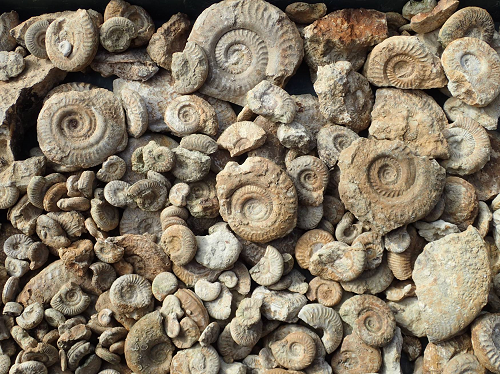 Right: A typical collection of Lower Toarcian ammonites from the ‘Junction Bed’ of the new site near Ilminster – dominated by Hildoceras.
Right: A typical collection of Lower Toarcian ammonites from the ‘Junction Bed’ of the new site near Ilminster – dominated by Hildoceras.
Clearly, the application of a reliable high-resolution timescale would help resolve many of these problems. This should be available using ammonites, which form the framework for all Jurassic chronologies. Recent work on the basal Jurassic Hettangian Stage in south-west Britain, for instance, has demonstrated that the finest subdivisions of such a time scale, known as ‘biohorizons’, can have a duration of as little as 20,000 years, with the bases of such units effectively forming time planes for global correlations.
The reason this works is down to the way in which ammonites behave. A single individual of any planktonic or nektonic organism, such as an ammonite, could theoretically circumnavigate the globe in just 2.56 years – even passively, by simply drifting in ocean currents (assuming, of course, that no physical barriers to such movement existed, such as land areas). The appearance of different species of ammonites – and indeed any other fossil group with a similar life cycle – in different parts of the world would therefore be effectively instantaneous in the geological record. This provides a stratigraphical resolution simply not available with any other correlation tool - excepting very rare events, such as meteorite impacts or large-scale volcanic events.
Although ammonites travelled widely, they tended to ‘live’ in distinct ‘bioprovinces’ – areas with a characteristic suite of species, typically controlled by factors such as climate, water temperature and physical barriers which block migrations.
In the Toarcian, correlations between northern (i.e. Subboreal in a bioprovincial sense) and southern Submediterranean and Mediterranean (bio)province areas in Europe using ammonites remain poor due to a lack of understanding of ‘southern’ faunas by authors in northern areas and vice versa for authors in southern areas. This issue is particularly problematic for the region in which the TOAE has been most extensively studied, the North Yorkshire coast around Whitby.
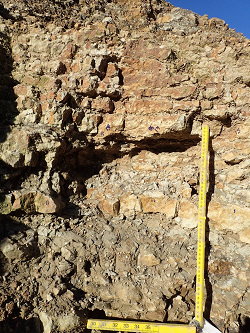 Left: Typical Barrington Member facies, with pale argillaceous limestones and grey marl bands and seams. The Exaratum-Falciferum subchronozone boundary (Serpentinum Chronozone) lies around the base of the bed labelled ‘13’, just below the middle of the picture.
Left: Typical Barrington Member facies, with pale argillaceous limestones and grey marl bands and seams. The Exaratum-Falciferum subchronozone boundary (Serpentinum Chronozone) lies around the base of the bed labelled ‘13’, just below the middle of the picture.
The coast around Whitby lies within the Subboreal Province, with ammonite faunas dominated by coiled-rope-like dactylioceratid ammonites. But as the boundary with the Submediterranean Province, which characterises most of the rest of Europe, lies across central England, even correlations between northern and southern Britain have often lacked the necessary precision (Submediterranean faunas are typically dominated by flat-sided, wavy-ribbed and keeled harpoceratid and hildoceratid ammonites, which are usually quite rare in Yorkshire). This problem is compounded in much of the UK literature, which has inflicted an inappropriate Yorkshire-style Subboreal ammonite zonation on southern Britain. In fact, southern Britain shows much greater similarities with the Submediterranean sequences of France, Spain and Portugal, including at both the historical type locality for the Toarcian at Thouars in western France, and its defining Global Stratotype Section and Point (GSSP) at Peniche in Portugal.
Improving these correlations has proven quite difficult. Although the Yorkshire coast sections remain spectacularly well-exposed in natural cliffs and foreshores – and comprehensively represented in museum collections, especially the Natural History Museum in London – equally useful exposures of Submediterranean sections have remained rare across much of Europe.
In Britain, sections of the Barrington Member of the Beacon Limestone Formation around Ilminster in Somerset – perhaps better known as the [Middle/ Upper Lias] ‘Junction Bed’ – have always had the potential to provide this new information. However, exposures of these ammonite-rich pelagic facies are even rarer, as the relatively soft limestone-marl alternations weather rapidly, but when exposures have been available, the results have often been spectacular.
A brief history of the Ilminster ‘Junction Bed’
 The first systematic sampling of the unit was by a local vicar, Charles Moore, in the mid-19th century. Elected a Fellow of the Geological Society in 1854, Moore was an avid collector, whose finds formed the basis of what is now the ‘Geological Museum’ of the Bath Royal Literary and Scientific Institution. In the late 1840s Moore discovered a rich and spectacularly well-preserved fish-reptile-insect fauna, within what is now known as the ‘Strawberry Bank Lagerstätten’. He made an extensive collection from the horizon, even washing marl samples and describing a number of microfossil species – some of the first ever descriptions in the geological literature.
The first systematic sampling of the unit was by a local vicar, Charles Moore, in the mid-19th century. Elected a Fellow of the Geological Society in 1854, Moore was an avid collector, whose finds formed the basis of what is now the ‘Geological Museum’ of the Bath Royal Literary and Scientific Institution. In the late 1840s Moore discovered a rich and spectacularly well-preserved fish-reptile-insect fauna, within what is now known as the ‘Strawberry Bank Lagerstätten’. He made an extensive collection from the horizon, even washing marl samples and describing a number of microfossil species – some of the first ever descriptions in the geological literature.
Image right: Charles Moore FGS (1815-1881) Geological Society of London Archives
Further interest in the ammonite sequence were stimulated some decades later, when in the early 1920s the ammonite guru S. S. Buckman and others collected from a group of exposures around Barrington - which is close to Ilminster – the most famous of which was created as a reservoir was constructed. He described many new species from the area is his classic ‘Type Ammonites’ series. This work could not be re-investigated, however, until the early 1970s, when a new reservoir section was sampled by Mike Howarth of the Natural History Museum in London. Not surprisingly, ammonites from the area were very well represented in his 1991-1992 Palaeontographical Society Monograph, where he announced that a remarkable 650 ammonites had now been recorded from these sections.
Some 16 years later in 1987, another section appeared in roadworks when a new A303 trunk road was driven across the area, by-passing Ilminster and other towns and villages. A group of intrepid PhD students from University College London jumped into a surprisingly sporty red hire car and headed for Somerset, to bag and tag mud for microfossil extraction. They had with them a trainee ammonite worker whose role was to help place the sampling into the standard Jurassic stratigraphical framework of ammonite ‘chronozones’ (i.e. explicitly subdivisions of the global chronostratigraphical timescale of System and Stages).
What became apparent very quickly was that the Subboreal ammonite zonation developed in North Yorkshire, which had been applied up to that point to all UK Lower Toarcian sections, was simply not going to work. It would be necessary to adopt a Submediterranean scheme for the new section, as applied across France to Spain and beyond.
Nevertheless, the nature of the exposures on the construction site was very frustrating; short-lived pits and small sections would appear at different times and in different places and hence no complete section of the Barrington Member was seen at one time. Most of the small sections did not last long enough to be systematically sampled for their ammonite fauna. Hence, even though the very well-exposed North Yorkshire sequence could still be restudied and a high-resolution sequence of ammonite biohorizons established, there was still not enough information from sequences in Somerset to do the same thing for Submediterranean areas.
Even re-examination of the only permanent exposure of the Barrington Member in the area, now protected as Hurcott Lane Section Site of Special Scientific Interest (SSSI), was very little help, as the high vertical faces along a dangerous country lane used as a ‘rat run’ by locals, are just not suitable – or indeed safe-enough - for systematic sampling.
A new hope
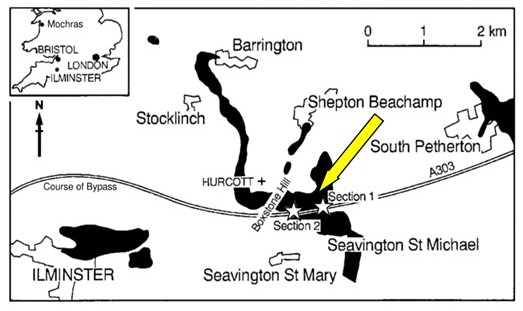 In around 2010 a new section became available, thanks to work commencing on the construction of a potato processing plant close to both the former Ilminster bypass sections and Hurcott Lane SSSI.
In around 2010 a new section became available, thanks to work commencing on the construction of a potato processing plant close to both the former Ilminster bypass sections and Hurcott Lane SSSI.
Left: The outcrop of the ‘Junction Bed’ around Ilminster in Somerset, modified from Boomer et al. (2009) – the arrow marks the location of the new sections.
There were difficulties with access initially – the site was subject to repeated raids by fossil collectors, many hoping to profit by selling the abundant ammonites. But by 2017 a local amateur, John Huxtable, had managed to negotiate access for scientific studies.
The access was granted initially for microfossil sampling by Ian Boomer (University of Birmingham) and Phil Copestake (Merlin Energy), and eventually for more general scientific sampling. The new sections revealed a complete and continuous sequence through 5m of the Barrington Member, from the top of the underlying ‘Marlstone Rock Bed’ (Upper Pliensbachian) below, to very close to the base of the Yeovil Sands Formation (Upper Toarcian) above – the most complete section in the Member recorded anywhere since the 1920s.
The Barrington Member is remarkable for its richness in pelagic forms - particularly ammonites, but also belemnites - and the relative rarity of any bottom living macrofauna, including the bivalves and brachiopods which are usually so common in shallower water Jurassic sediments. An assumption that the environment was relatively deep is inescapable, reflecting the high sea-levels of the Lower Toarcian – although the microfauna of foraminifera and ostrocods is not so categorical.
As sampling for ammonites progressed, it soon became apparent that this was going to have to be archaeological in style due to richness of the faunas. A B&Q putty knife became as useful as a conventional geological hammer, as the sequence was scraped and dug through, centimetre by centimetre. Such sampling would not have been possible without the support of the Geological Society through the award of the Gloyne Outdoor Geological Research fund to offset the costs, which was very gratefully received!
3000+ ammonites later
Right: The ‘TOAE’ (Toarcian Oceanic Anoxic Event) revealed in dark marls near the base of the ‘Junction Bed’ sequence. The crushed ammonite is a Harpoceratoides of the serpentinum group.
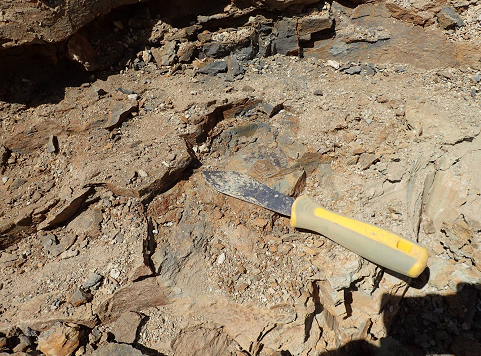 Sampling began in the mists and rain of late October 2018 – but by the beginning of 2020, some 3000+ ammonites later, new discoveries are still being made.
Sampling began in the mists and rain of late October 2018 – but by the beginning of 2020, some 3000+ ammonites later, new discoveries are still being made.
The core ammonite sequence is dominated by Submediterranean subfamilies Harpoceratinae and Hildoceratinae. The sequence of species for both subfamilies is the most complete known anywhere in Europe, with at least 10 successive species of Harpoceratoides-Harpoceras lineage and 13 of the Hildaites-Hildoceras group. Subboreal Dactylioceratidae are only common in the lower part of the sequence, with later genera such as Peronoceras and Catacoeloceras, which are abundant in North Yorkshire, being rather rare.
There have been two very notable new records. Firstly, Eodactylites at the base of the Toarcian, an indicator species of the base of the stage at its GSSP in Portugal, and often considered to be virtually absent in Britain. Secondly, the taxonomic usefulness of a previously rather ‘suspect’ genus has finally been clarified with the discovery of the type horizon of ‘Rakusites pruddeni’, named by the Swiss specialist Jean Guex in 1971 in honour of one of Somerset’s most famous geological promoters, the late Hugh Prudden.
In all, over 55 successive levels have been sampled, some yielding over 100 ammonites. The richness of the faunas means that rarer forms have also been found. Many of these are also rare in Submediterranean sections across Europe, and hence as ‘exotics’ may have limited correlation value across the Province. They can be much more common, however, in true Mediterranean sequences bordering the Tethys Ocean further south, for instance in Italy and Morocco, so provide tantalising possibilities for correlations beyond Europe.
Other notable discoveries include new records for Britain of the elegant Tethyan Harpoceratinae, Polyplectus and Osperlioceras, the Ethiopean Bouleiceratid Frechiella, as well as Arctic Cleviceras, Ovaticeras and Pseudolioceras (all Harpoceratinae - but also known, not surprisingly, from North Yorkshire). As processing and washing of the vast amount of material bagged and tagged to date proceeds, new records will undoubtedly appear.
From ‘relative’ to ‘real’ time
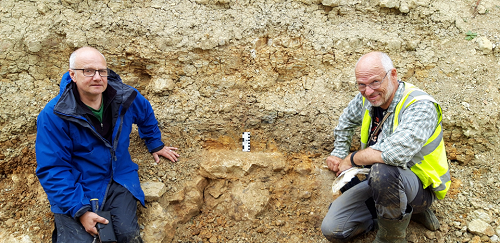 Left: Integrated biostratigraphy: Ian Boomer (left), ostrocods, Kevin Page (right), ammonites. Photo courtesy of Phil Copestake (foraminifera). The Geological Society scale rests on the base of the Toarcian with Eodactylites.
Left: Integrated biostratigraphy: Ian Boomer (left), ostrocods, Kevin Page (right), ammonites. Photo courtesy of Phil Copestake (foraminifera). The Geological Society scale rests on the base of the Toarcian with Eodactylites.
The next stage in the process will be to decide which of the new 55+ successive faunas can form the basis for a new sequence of ammonite-correlated high-resolution biohorizons for the Submediterranean Province. This will improve not only north-south Lower Toarcian correlations across Europe, but also correlations globally, as many of the genera present in Europe have counterparts elsewhere – and the ‘exotics’ mean that links at the species level can also help draw time-lines to much more distant regions.
In addition, this new and very high-resolution ‘relative’ timescale based on ammonites will soon become a ‘real’ timescale, as Milankovitch orbital cycle calibration of the Toarcian Stage is underway as part of the JET (Jurassic Earth Systems and Timescales) Project (http://blogs.exeter.ac.uk/jet/). Just as the earlier Hettangian study confirmed the incredibly short duration of ammonite biohorizons and gave the Stage and its component ammonite chronozones and subchronozones a real timescale in 1000s of years, such a timescale will soon be available for the Toarcian. With such a framework in place, it will finally be possible to make reliable statements about the chronology of Early Toarcian events, including the famed TOAE. Crucially, as this new chronology will be independent of any oceanic chemistry or ecological changes, it will, for the first time, provide a reliable test of synchronicity, duration and even rates of change through this remarkable time interval.
Author
Kevin Page is Geoheritage and Geodiversity specialist and Honorary Senior Research Fellow at Camborne School of Mines, University of Exeter. He is Editor in Chief of the journal Geoheritage. Email: [email protected]/[email protected]
References
BOOMER, I., LORD, A.R., PAGE, K.N., BOWN, P.R., LOWRY, F.M.D. & RIDING, J.B. 2009. The biostratigraphy of the Upper Pliensbachian-Toacian (Lower Jurassic) sequence at Ilminster, Somerset. Journal of Micropalaeonotology 28: 67-85.
BUCKMAN, S.S. 1909–1930: Yorkshire type ammonites (1, 2), continued as Type ammonites (3–7), 790 plates. London & Thame: Wheldon & Wesley (1), the author (2–7).
HOWARTH, M. K. 1992. The ammonite family Hildoceratidae in the Lower Jurassic of Britain. Monographs of the Palaeontographical Society, London: 200pp, 38pl.
HUXTABLE, J. G. 2011. A review of a new section in the Beacon Limestone Formation (Barrington Member) and Marlstone Rock Bed (Pliensbachian-Toarcian Stages, Lower Jurassic) near Seavington St Michael, South Somerset. Somerset Archaeology and Natural History, 2011: 284–299
JENKYNS, H. C. 1988. The Early Toarcian (Jurassic) anoxic event; stratigraphic, sedimentary and geochemical evidence. American Journal of Science 288(2), 101-151.PAGE, K.N. 2003. The Lower Jurassic of Europe - its subdivision and correlation. In: INESON, J and SURLYK, F., (eds). The Jurassic of Denmark and adjacent areas. Geological Survey of Denmark and Greenland, Bulletin 1: 23-59.
PAGE, K.N. 2008. The evolution and geography of Jurassic ammonites. Proceedings of the Geologist’s Association 119: 35-57
PAGE, K.N. 2017. From Oppel to Callomon (and beyond!): Building a high-resolution ammonite-based biochronology for the Jurassic System, Lethaia, DOI: 10.1111/let. 12209.
WEEDON, G. P., PAGE, K. N. and JENKYNS, H. C. 2018. Cyclostratigraphy, stratigraphic gaps and the duration of the Hettangian Stage (Jurassic): insights from the Blue Lias Formation of Southern Britain. Geological Magazine, DOI: https://doi.org/10.1017/S0016756818000808
WILLIAMS, M., BENTON, M.J., and ROSS, A. 2015. The Strawberry Bank Lagerstätte reveals insights into Early Jurassic life. Journal of the Geological Society, 172, 683-692, https://doi.org/10.1144/jgs2014-144